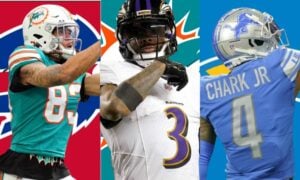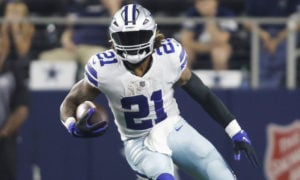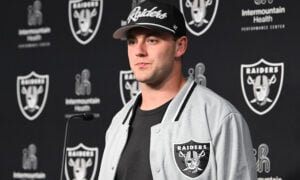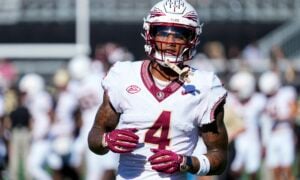The Lesser Knowns: Part One
After watching Twitter and the internet since returning from Mobile, there is already a consensus of people’s opinions on the so-called best NFL Draft and fantasy prospects. Much of their talents get debated over and over. I want to take a few articles to discuss the “lesser known” for the lack of a better term. These are the players who have talent, but maybe play in smaller schools or are just less publicized than a TeddyBridgewater, Carlos Hyde, Sammy Watkins, etc.
There will be a lot of player evaluations from many sources for the next four or so months, make sure you trust your sources. Like everyone reading this, I am a football fan who started watching the game at age five (I’m 44 now). Football is in my blood as I have an uncle who coaches at the high school level, two brothers who made the all-state team at running back, and a cousin who played in the Mid-American Conference. Speaking for myself, I played high school football in Ohio around the Canton area on the offensive line: center, right guard, and right tackle. On the defensive front, I was an inside and outside linebacker who started off my career at defensive end. During college, I worked as a football official for the college intramural program for two years as well as played in that program for three. I started writing my scouting thoughts down about three years ago and shared my evaluations with Shane Hallam and Joe Everett. We discussed players at length and I got a better idea of what to look for while scouting. Last year I took the National Football Post’s two month scouting class, also attended by Bryan Perez aka @FirstRoundGrade on Twitter, right before I attended the East/West Shrine game. This season I went to the Senior Bowl and all the practices I could attend with both Hallam and Everett to confer. Scouting is about not only what you can see, but what you can “prove” with the numbers. Being an accountant by day is quite helpful, but enough of my ramblings, on to the players.
Robert Herron, WR WYO
My first exposure to Herron was at the Senior Bowl practices and I came away impressed with his athleticism. After watching three of his games against New Mexico, Nebraska and Texas, the rookie was better than I originally thought. Sure, he is only 5′ 8″, but has a solid, powerful build at a muscular 193 lbs. (Senior Bowl weigh-in). This mostly slot receiver has soft hands, catches the ball at the highest point and fights for the ball on every target. Herron runs clean, precise routes and is quite good on bubble screens as he looks like a running back with the ball in his hands on the open field. He was even better when used on sweeps and reverses, which took advantage of his quick feet and shoulder fakes.
The future rookie is so dangerous with his sudden burst and determination to fight for contested passes. He is shifty with good body control to contort to poorly throw balls all while making defenders miss in traffic. There were at least two catches in the three games I viewed where Herron got smashed, kept his feet driving as he broke free for at least an additional 10-20 yards down the field (some times more). The receiver sets up the defensive backs with double moves, or breaks out a spin move to create separation. Heron tracks the ball well in the air and can get behind a defense if they aren’t careful. He has a low center of gravity, so make sure you don’t tackle him high as he keeps his feet chopping until he is down or in the end zone.
The receiver won’t be ideal for all offenses, but could turn out to be a poor man’s Steve Smith with his tenacity and burst. With all the buzz the junior receivers have gotten (Watkins, Lee, Evans, Benjamin), Herron could be available in the late second to early third round in rookie drafts which is huge value.
Brent Smith, QB WYO
Here is a quarterback you don’t hear much about, even now. When I first watched Smith, the first thought that jumped to my mind was Napoleon Dynamite’s Uncle Rico. They both have a sidearm delivery that is off-balance and unorthodox. He throws mostly with his upper body, despite setting his feet, and lifts the back foot in the air to complete his throw. The funny thing is he is fairly accurate with a better than average arm. Smith doesn’t toss many frozen ropes, instead he prefers to get some air underneath his attempts – that is a little concerning as he did not face the best level of defensive back competition playing in the Mountain West Conference and he may need to adjust his arch to avoid turnovers.
The young signal caller gets the ball out fast. He will either throw or turn and run quickly. Despite his 6′ 3″ 206 lbs. size, Smith is a very mobile athlete who is quite good at making defenders miss with his quick feet and good balance. I am a bit concerned that his body is not built to take the punishments that an NFL defense will dish out during a game though. The quarterback has a good internal clock as he senses pressure fairly well and is just as accurate on the run as he is in the pocket. If the play needs extended, the quarterback will use his feet to create more time. Smith can fit the ball in tight coverage and isn’t afraid to throw the ball away if the pass isn’t there. He had a tendency to throw the ball short on bubble screens than to attempt down field passes, so Smith might need to get focused by his NFL coaching staff in that regard. If his “Uncle Rico-ness” can be coached out of him, I think he could be a nice developmental quarterback who could start a year or two down the road. Smith would be ideal for leagues with taxi squads that give you time to develop players.
Don’t worry, I have another thirteen players I want to discuss in the next two weeks, including Towson running back Terrance West, California tight end Richard Rodgers, Montana linebacker Jordan Tripp and many more.
For further questions or comments, please contact me on twitter @AndrewMiley

































































